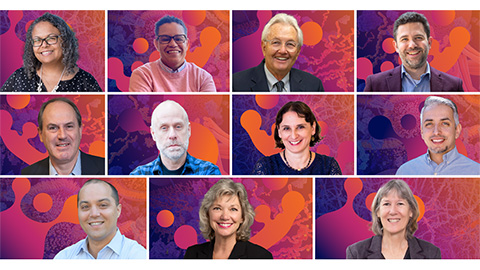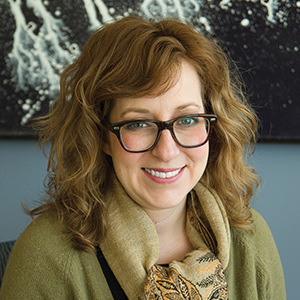Solving the faculty diversity problem
Last fall, a paper in the journal eLife called into question the wisdom that the key to diversifying the faculty hiring pool is focusing on building the talent pool of underrepresented scientists. The paper showed that diversity within the Ph.D. pool has increased dramatically. The problem is that scientists from underrepresented backgrounds aren’t being hired at the rate needed to establish parity in basic science departments (1).
“My goal is to use data to demonstrate clearly and quantitatively that there’s a robust talent pool of scientists from underrepresented backgrounds. We can stop having conversations based on the idea that scientists of color don’t exist,” says Kenneth Gibbs Jr., the lead author of the paper.
 Kenneth Gibbs Jr.PHOTO COURTESTY OF KENNETH GIBBS
Kenneth Gibbs Jr.PHOTO COURTESTY OF KENNETH GIBBS
As a program director at the National Institute of General Medical Sciences in the Division of Training, Workforce Development and Diversity, Gibbs isn’t in the business of advising faculty hiring committees or department administrators. But the model he and his colleagues developed spells out for hiring managers what they have to do, collectively, to establish a national faculty body that reflects the talent pool and comes closer to reflecting the American population.
“If two-thirds of the medical schools hired and retained one faculty member from an underrepresented background every year for six years, the system would reach parity with the Ph.D. pool in one tenure cycle,” explains Gibbs.
Bottom line: Diversifying the faculty is not unsolvable. As Gibbs puts it, “the mathematical reality is that it takes around 100 assistant professor hires annually to reach parity with the Ph.D. pool. It’s just arithmetic.”
Gibbs earned his bachelor’s degree in biochemistry at the University of Maryland, Baltimore County, and his Ph.D. in immunology at Stanford University. He became a science policy fellow for the American Association for the Advancement of Science, completed a postdoctoral fellowship at the National Cancer Institute, and then joined the NIGMS.
For the paper, Gibbs teamed up with Jacob Basson, a biostatistician at the NIGMS; Imam M. Xierali, who manages the American Association of Medical Colleges’ diversity programs; and David Broniatowski, an assistant professor who directs the Decision Making and Systems Architecture Laboratory at the George Washington University.
ASBMB Today’s executive editor, Angela Hopp, talked to Gibbs about his interest in workforce diversity, his team’s findings and obstacles to achieving parity. This interview has been edited for length, style and clarity.
You wrote about how the metaphor of the STEM pipeline doesn’t stand. Why don’t you like it?
I appreciate where people are trying to come from. There is a clear educational pathway to scientific independence. (Common wisdom is that) the only way you get more scientists of color in the end is to stuff more at the beginning. That would lead you to believe that workforce diversity challenges are mainly about a lack of diversity early on, but empirically that doesn’t work out. Moreover, even if we had a clear pipeline, current conversations about this topic often ignore the shearing forces that are inside the pipe. When training environments and climates do not support all trainees, including minority trainees, that is a shearing force that we need to change.
Also, I really don’t like the notion of leaking, as it takes agency away from people. I did not leak out of any path. I actively made decisions about my career. I work in science policy, as do many contemporaries who are from well-represented racial backgrounds. When my white male colleagues make a choice similar to mine, it’s not referred to as “leaking,” but when people of color or women choose a career outside of academia, we’re called “leaks.” I don’t like that. Nobody leaked. Everybody is making choices. To really get at workforce issues, including diversity, we need to understand those choices and address the root causes of those choices.
Conversations about a “leaky pipeline” take our attention away from what we have: a talent pool of thousands of scientists of color. Let’s acknowledge that reality and, as a community, work to ensure we are utilizing this talent pool.
When and how did you get started in this work?
I was an AAAS policy fellowship for two years at the National Science Foundation in the Directorate for Education and Human Resources in the Division of Human Resource Development. I got interested in understanding what was happening with me and my peers as it related to our career development.
I was in a number of different meetings where I was hearing talk about young scientists broadly and young scientists of color particularly that did not seem to match my own life experience. I also recognized, as a scientist, that questions such as “Why do Ph.D. scientists make the career decisions they do?” and “How do the decisions differ across demographics?” can be addressed empirically.

You were hearing people say what in those meetings?
One was that (scientists of color) didn’t exist. That didn’t align with my experience. I look in the mirror every day and see a black man scientist. I see hundreds of them on Facebook.
Two, there was a conflation of race and poverty. I grew up middle class. I’m an “n” of one and recognize that a fair number of peers had greater proximity to economic struggle, but that’s definitely not the case for all underrepresented scientists.
There was also the idea that we were all at minority-serving institutions. These are great institutions. However, I had many underrepresented colleagues at places like Stanford, Harvard, Hopkins and Duke.
Specifically, I had three black women friends who completed their Ph.D.s at elite East Coast institutions and who had first-author papers in (the Proceedings of the National Academy of Sciences), Nature and Science. However, their graduate school experiences were so challenging and, frankly, hostile that at the end two of them said, “I’m completely out of science,” and the other one said, “I will do research, but I’ll never stay in academia.” This is a loss for all of us, because these excellent scientists are accomplishing at the highest levels of our field, and they don’t feel there’s a place for them within our system.
Then there was one of my white male colleagues, probably one of the smartest people I’ve met in science, who chose to start a business instead of pursuing academia. I began to wonder: Why is anybody doing what they’re doing? Are the reasons that my white male colleagues are moving out of science the same reasons as those of these black women that I know? Why are these postdocs staying for six to eight years to try to get a faculty position?
I recognized that I could not change everything, but we can illuminate what is happening. Change happens when people start thinking about the world differently. I decided I’m going to research it.
Tell me about your education and career path.
I am a black American whose family has been here for centuries, meaning slavery and Jim Crow are part of our history. My grandfathers had fourth- and eighth-grade educations, and my grandmothers both had high school diplomas. My mother and father were the first people in their families to graduate from college, and that set up a worldview for me in which education was very important.
I grew up in Durham, North Carolina, the Research Triangle Park. I did lots of internships in high school and got really hooked on the idea of scientific research and what scientific research can do to be helpful to humanity as a whole, so I pursued a career as a scientist.
I went to the University of Maryland, Baltimore County, as a Meyerhoff scholar. I also had funding from the (Maximizing Access to Research Careers) program at NIGMS, and the Howard Hughes Medical Institute.
I got a biochemistry and molecular biology undergrad degree and did my Ph.D. in immunology at Stanford University, where I focused on intersections of stem cell biology, signaling biology and cancer biology, at which point I had my existential crisis.
You weren’t sure if you wanted to stay at the bench?
Remember, I started doing research as a high-schooler. My first job was working in a lab. I worked in labs at the (University of North Carolina) and at Duke (University) and in the 10th and 11th grades. So I’d been doing research from the age of 15, and I finished my Ph.D. when I was 26.
I wanted to take a step back and see if this was what I wanted to be doing. I can do it, and I enjoy it. But is it a thing that I really want to be doing?
This was before the distress in the Ph.D. workforce was en vogue to talk about. I completed grad school from 2005 to 2010, so this was before it was widely known. But observationally, I could see something weird was happening around people getting jobs. People were doing postdocs for seven years, with Cell papers, and not getting jobs.
At that point you took the AAAS fellowship, which set you off on this policy route.
The more I explored, the more I kept coming back to these really compelling workforce questions.
I paired with a colleague of mine, Kimberly Griffin, who is an education researcher at the University of Maryland. My goal has been to quantify the qualitative aspects of our enterprise, because scientists respond to numbers, not quotes. We started writing papers and got some support from the AAAS’s education unit and the Burroughs Wellcome Fund, and we’ve written a series of papers on biomedical workforce development (2–4).
Given that you felt the pipeline metaphor was inadequate, did that play into your decision with this eLife paper?
Yes, exactly. I was thinking about it as a system instead of a pipeline. Where do people move in and out, and what are points of leverage that can help achieve certain outcomes?
From an NIH perspective — again, not a policy perspective, but just a factual reality — most of our money goes to medical colleges. And so biomedical workforce diversity is linked to faculty diversity in those specific contexts. I also figured examining these environments could help illuminate what’s happening in other contexts, because many scientific environments have these challenges. We focused on medical schools because of access to high-quality longitudinal data.
Which brings us to your findings.
We wanted to know what actually has been happening over the past 30-plus years — from 1980 to 2014 — as it relates to (1) Ph.D. production among scientists from underrepresented and well-represented backgrounds and (2) progression into assistant professor positions in basic science departments. We then used these data to build a conceptual model of the workforce and used the model to test the impact of different intervention strategies in the short and long term.
We used the NSF Survey of Earned Doctorates, which (the Federation of American Societies for Experimental Biology) very nicely compiles every year on Ph.D. production (5), and the AAMC faculty roster for faculty data (6). In 1980, there were 93 Ph.D. graduates from underrepresented backgrounds, and that had grown to 868 by 2013. And in 1980, there were 132 assistant professors from underrepresented backgrounds in basic science departments, and that grew to 341 by 2014.
We see similar trends for scientists from well-represented backgrounds — that is, both populations grew. But then you see that from 1980, the underrepresented student population has grown 9.3-fold, whereas the professor population has grown 2.6-fold. The rate of growth for underrepresented Ph.D. (holders) is much greater than it is for underrepresented faculty.
Already, you could see that the pool is not depleted of underrepresented scientists.
What we see is that the pool of scientists from underrepresented backgrounds has grown almost eight-fold in the past 30 years, compared with two-fold growth for the well-represented candidates. The sizes of the pools are different by an order of magnitude, but, all things being equal, as the pools grow, you’d anticipate comparable entry into these faculty positions. That’s not what we see.
What we see is that for scientists from well-represented backgrounds, as the pool grows, more people are hired. But there’s statistically no relationship between the size of the talent pool for underrepresented scientists and the number of assistant professors hired.
The number of underrepresented candidates has grown but academe is hiring a smaller portion than it used to.
The nine-fold growth in the number of underrepresented Ph.D.s and the almost eight-fold growth in the underrepresented talent pool suggests that the collective action of the community to focus on and build the underrepresented talent pool has had an effect. This rate of growth is much larger than the growth of those populations in the country since 1980.
What we’re seeing, though, is a lack of connection between the talent pool and academic hiring. Between 2005 and 2013, there were close to 6,000 underrepresented scientists who got Ph.D.s in the biomedical sciences, and between 2005 and 2014 there were six fewer underrepresented assistant professors. There’s a disconnect that needs to be addressed.
Now explain the model.
.jpg?lang=en-US)
The logic of the model is this: You have some number of people who aspire to these positions. They go into the market. And then people are hired based on the number of slots available.
In our model, there is no bias in hiring. People are hired directly proportionately to their representation on the market. So, if there are 90 well-represented folks and 10 underrepresented folks on the market and there are 10 slots, nine go to the well-represented folks and one goes to an underrepresented person.
Historically, there was some number of people who would have become faculty no matter what. There were minority professors in the 1970s when things were really terrible. There’s some number that always is there.
We wanted to know how many additional people were over and above what would be expected with overall system growth through time. Using real data, in 2014, 5.8 percent of the assistant professors were underrepresented minorities. And that would be consistent with a 0.25 percent transition rate of URM scientists. That is, even though we’re doing a lot to grow the URM talent pool, it looks like very few of these people are transitioning into the faculty pool.
You also tested some interventions, right?
We used the model to test the impact of three interventions in the short and long term. These interventions were: focusing on building the talent pool, increasing the number of faculty positions available, and increasing the transition rate of underrepresented Ph.Ds. onto the faculty market and their subsequent hiring.
All the models showed the same thing. If we only focus on growing the URM talent and let it grow exponentially, by 2080 we would have 73 percent underrepresented minority Ph.D.s but only 8.9 percent underrepresented minority faculty. The low transition rate means that even without active discrimination, the system operates in such a manner that the URM talent pool is disconnected from academic hiring.
To see if it was an issue of the number of jobs, we added 100 new assistant professor positions annually starting in 2015. Even with exponential growth in the underrepresented Ph.D. pool, there’s still no impact.
Finally, we examined the impact of increasing the transition rate — that is, getting more URM postdocs onto the market. This dramatically increased faculty diversity, because as more URMs enter the market, more are hired. You only get diversity in the faculty if you get people into the market and hire them. Changing the pool or the labor market are not sufficient to increase diversity. We have to think about transitions and hiring.

Bottom line?
Change is possible now. The reality is that there are about 1,000 assistant professors hired every year across the country. If you hire around 1,000 people a year, and you want 10 percent to be people from underrepresented backgrounds, which would match the Ph.D. pool, then that would mean hiring 100 underrepresented minority assistant professors a year.
We graduate close to 900 (underrepresented) Ph.D.s a year.
All of this is to say that we sometimes talk about issues of diversity as if they cannot be fixed. This can be solved with around 100 people.
We assumed (in the past) that growing the talent pool would be sufficient to right the system. This (paper) calls that into question. It speaks to the need, I think, to recognize that this is happening and then that there can be systemic architecture issues going on that are outside of the motives of any individual person’s heart. Those issues need to be addressed so that this disconnect doesn’t continue.
How hopeful are you that institutions will do this?
I believe that it can be done. We live in an interesting cultural moment. Science is not immune from the broader societal challenges as they relate to issues of race, and lots of institutions are examining if their practices are keeping up with broader changes in the world. It is possible, though it will take changing the way we’ve always done things.
Ultimately the goal is to enhance scientific excellence through diversity. If large sections of the workforce are disconnected from academic science, scientific excellence suffers. This paper focused on scientists from underrepresented backgrounds, but many of these issues also apply to women from well-represented backgrounds.
You are careful not to call your projections as “quotas.”
Correct. It’s a mathematical reality that it takes around 100 scientists from underrepresented backgrounds each year to reach parity with the Ph.D. pool.
You’re not making, then, recommendations.
I am describing reality with the hope that we can have a broader conversation in the scientific community about how we ensure that we can effectively utilize the diverse talent pool that we have before us.
Medical schools could commit to doing this, if they really wanted to.
I think it’s important for all actors in the system — individual scientists, institutions, funding agencies, scientific societies — to think about how they can individually and synergistically work to address the issues that have been illuminated by this paper.
References
Enjoy reading ASBMB Today?
Become a member to receive the print edition four times a year and the digital edition monthly.
Learn moreFeatured jobs
from the ASBMB career center
Get the latest from ASBMB Today
Enter your email address, and we’ll send you a weekly email with recent articles, interviews and more.
Latest in Careers
Careers highlights or most popular articles

Make your abstract stand out
Ensure your research is impossible to overlook. Get quick, practical reminders for crafting an abstract that attracts readers and helps you build connections at the conference.

Inside industry postdocs
As more Ph.D. scientists look beyond academia, industry postdocs offer a new kind of training, where mentorship meets mission-driven research. Fellows at Pfizer and Genentech share how these programs prepare them to translate discovery into impact.

Upcoming opportunities
The Lipid Research Division Seminar Series returns Oct. 15 with talks on recent advances in triglyceride cycling in adipocytes.

Writing with AI turns chaos into clarity
Associate professor shares how generative AI, used as a creative whiteboard, helps scientists refine ideas, structure complexity and sharpen clarity — transforming the messy process of discovery into compelling science writing.

Upcoming opportunities
Register for the free ASBMB webinar on the power of "Yes" and knowing when to use it, coming up on Sept. 30!

ASBMB names 2026 award winners
Check out their lectures at the annual meeting in March in the Washington, D.C., metro area.

